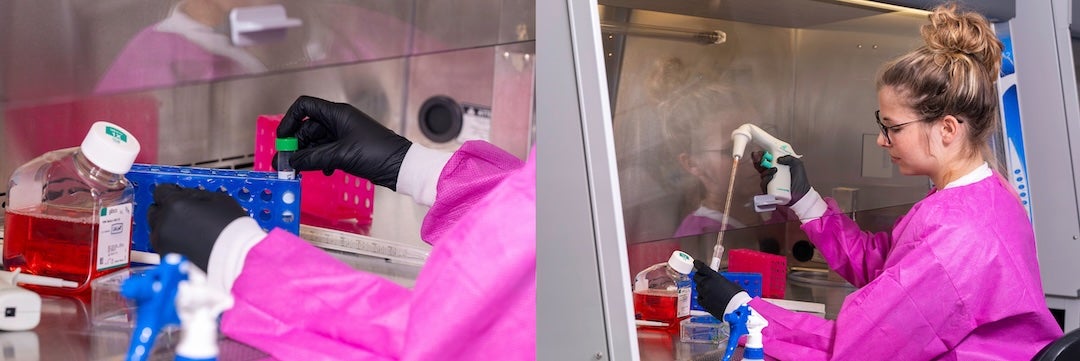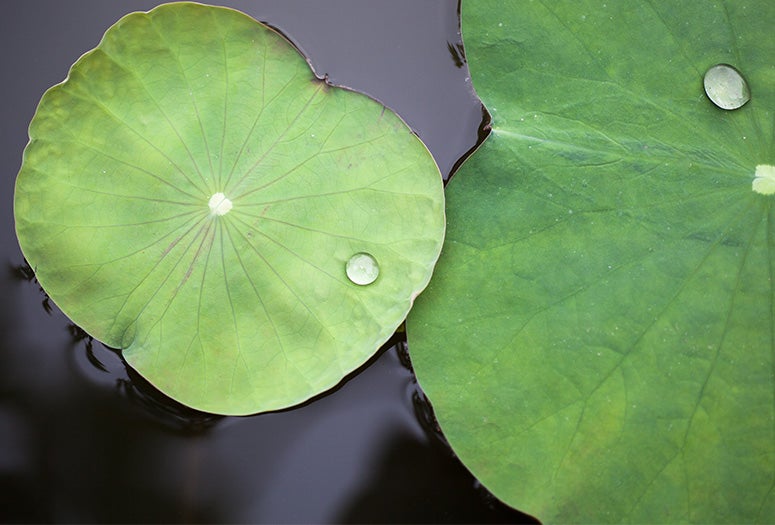The lotus leaf is a pioneer of self-cleaning, water-repellant engineering. Water droplets all but hover on its surface, whose unique texture traps air in its nanosized ridges and folds.

Rice University bioengineers report harnessing the lotus effect to develop a system for culturing cancer cell clusters that can shed light on hard-to-study tumor properties. The new zinc oxide-based culturing surface mimics the lotus leaf surface structure, providing a highly tunable platform for the high-throughput generation of three-dimensional nanoscale tumor models.
The superhydrophobic array device (SHArD) designed by Rice bioengineer Michael King and collaborators can be used to create tunable, compact, physiologically relevant models for studying the progression of cancer, including metastasis ⎯ the stage in the disease when cancerous cells travel through the bloodstream from a primary tumor site to other parts of the body.
“The study of metastasis ⎯ the leading cause of cancer deaths ⎯ poses a particular challenge in part due to the difficulty of developing accurate, high-throughput models,” said King, who is corresponding author on a study published in ACS Nano that describes the new culturing platform. “We hope this tool will unlock new knowledge about this problematic stage of the disease and help us identify ways to intervene in order to stop or prevent it from happening.”
Scientists and clinicians now rely on blood samples containing circulating tumor cells ⎯ a key marker of metastasis ⎯ to understand the properties of primary tumors as well as what causes cancer to spread. Often referred to as “liquid biopsy,” this sampling approach typically does not yield enough of a “catch” to enable in-depth, large-scale studies of metastatic processes.

“‘Safety in numbers’ unfortunately also applies to cancer cells circulating in the bloodstream,” said Alexandria Carter, a researcher in the King lab who is a co-author on the study. “Cancer cells traveling alone are more likely to succumb to shear stress destruction or immune cell attacks. However, when they travel in groups, the likelihood that they successfully reach and settle in other parts of the body increases.
“Those few lone cancer cells in a single blood draw are already rare, so isolating enough clusters for a detailed study is especially challenging. This is why SHArD is an exciting new tool for understanding primary and metastatic cancer.”
The King lab had previously succeeded in creating nanorod layers of halloysite, a naturally occurring substance whose texture promotes the adhesion of circulating tumor cells while simultaneously repelling blood cells.

“When Kalana Jayawardana joined our lab as a new postdoctoral fellow in 2018, he started to experiment with growing zinc oxide nanorod surfaces,” said King, a Cancer Prevention and Research Institute of Texas Scholar who recently joined Rice as the E.D. Butcher Chair of Bioengineering and special adviser to the provost on life science collaborations with the Texas Medical Center. “At first, we didn’t have a specific application in mind, but we were curious and hopeful that the new material would have special properties that would be useful for cancer biology.”
The project was later taken over by a doctoral student in the King lab, Maria Lopez-Cavestany, and took off in an exciting direction. Cavestany, now a Ph.D. graduate, is the first author on the study.
Once they were able to grow a stable “carpet” of zinc oxide nanotubes, the researchers added a teflonlike coating on top, in essence recreating the lotus leaf structure ⎯ nanoscale roughness combined with a hydrophobic layer that together gave rise to true superhydrophobicity, a word stemming from the Greek for “extreme fear of water.” To create SHArD, the researchers added a microwell grid with perfectly sized compartments, then tested the system to assess its performance.
“SHArD is ready to use in biomedical research,” Carter said. “Any lab with clean room access can follow our protocols and create versions of this platform that meet the exact needs of their specific research projects.”

Initially intended as a means to reliably culture primary tumor models at a higher throughput, SHArD is highly tunable and can easily be adapted to culture metastatic clusters as well. The fact that SHArD was successfully used to grow spheroidal models of primary tumors already expands the cancer modeling toolkit, making it possible to create superhydrophobic culturing devices in the absence of highly specialized equipment.
“The cluster-forming device has opened the door to new areas of research into the dangerous clusters found in the bloodstream of late-stage cancer patients,” King said.
The research was supported by the National Institutes of Health (CA203991). The content in this press release is solely the responsibility of the authors and does not necessarily represent the official views of the supporting entities.
- Peer-reviewed paper:
-
Superhydrophobic Array Devices for the Enhanced Formation of 3D Cancer Models | ACS Nano | DOI: 10.1021/acsnano.4c08132
Authors: Maria Lopez-Cavestany, Olivia A. Wright, Noah T. Reckhorn, Alexandria T. Carter, Kalana Jayawardana, Tin Nguyen, Dayrl P. Briggs, Dmitry S. Koktysh, Alberto Esteban Linares, Deyu Li and Michael King
https://doi.org/10.1021/acsnano.4c08132 - Image downloads:
-
https://drive.google.com/drive/folders/1vrDLsGEVw2pe7eJnPBN6Ypkw_jncOS7-?usp=drive_link (Photos by Gustavo Raskosky/Rice University)

